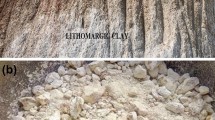Abstract
Marine clay is present along the coastal region all around the world. This soil is highly problematic and unfit to support any engineering structures. They are characterized by high liquid limit, high plasticity index with low shear strength and high compressibility. The primary by-product generated from the ferrous industry is granulated blast furnace slag (GBFS), and CaO present in GBFS acts as a binding agent. This paper describes the detailed experimental results by incorporation of GBFS and cement to the marine clay. Soil was replaced by GBFS in various percentages (10%, 20%, 30%, 40% and 50%) and addition of cement (2%, 4%, 6%, 8% and 10%) in percentage of dry weight of soil. Soil and various mixtures are examined for its geotechnical properties, which include specific gravity, consistency limits, compaction characteristics, unconfined compression strength and strength parameters. From the unconfined compression test results, 40% GBFS replacing the marine clay is concluded as the optimum mix. Improvement in the strength is due to the formation of CSH, CAH, CASH and other cementitious compounds which are observed in SEM and XRD studies. From the investigation, it is concluded that GBFS with or without cement can be used as a potential stabilizer for soft marine clay.













Similar content being viewed by others
References
Shen Z, Cao Y, Fang L (2017) Experimental investigation of rapid stabilization of soft clay soils using chemical admixtures. Soil Mech Found Eng 54:202–210. https://doi.org/10.1007/s11204-017-9459-z
Yi Y, Li C, Liu S (2014) Alkali-activated ground-granulated blast furnace slag for stabilization of marine soft clay. J Mater Civ Eng 27:04014146. https://doi.org/10.1061/(asce)mt.1943-5533.0001100
Al-Bared MAM, Marto A, Latifi N (2018) Utilization of recycled tiles and tyres in stabilization of soils and production of construction materials—a state-of-the-art review. KSCE J Civ Eng 22:3860–3874. https://doi.org/10.1007/s12205-018-1532-2
Mirzababaei M, Arulrajah A, Horpibulsuk S et al (2018) Stabilization of soft clay using short fibers and poly vinyl alcohol. Geotext Geomembranes 46:646–655. https://doi.org/10.1016/j.geotexmem.2018.05.001
Pourakbar S, Asadi A, Huat BBK (2015) Transportation Geotechnics Stabilization of clayey soil using ultrafine palm oil fuel ash (POFA) and cement. Transp Geotech 3:24–35. https://doi.org/10.1016/j.trgeo.2015.01.002
Joseph A, Sankar SCN (2018) Performance of compacted lime column and lime-fly ash column techniques for cochin marine clays. Int J Geosynth Ground Eng. https://doi.org/10.1007/s40891-018-0147-5
Rao SM, Sridharan A, Chandrakaran S (1990) Engineering behavior of uplifted smectite-rich Cochin and Mangalore marine clays. Mar Geotechnol 9:243–259. https://doi.org/10.1080/10641199009388243
Jose BT, Sridharan A, Abraham BM (1988) A study of geotechnical properties of Cochin marine clays. Mar Geotechnol 7:189–209. https://doi.org/10.1080/10641198809388216
Lin D, Lin K, Hung M, Luo H (2007) Sludge ash/hydrated lime on the geotechnical properties of soft soil. J Hazard Mater 145:58–64. https://doi.org/10.1016/j.jhazmat.2006.10.087
Yong RN, Ouhadi VR (2007) Experimental study on instability of bases on natural and lime/cement-stabilized clayey soils. Appl Clay Sci 35:238–249. https://doi.org/10.1016/j.clay.2006.08.009
Baldovino JA, Moreira EB, Teixeira W et al (2018) Effects of lime addition on geotechnical properties of sedimentary soil. J Rock Mech Geotech Eng 10:188–194. https://doi.org/10.1016/j.jrmge.2017.10.001
Sekhar C, Nayak S (2017) SEM and XRD investigations on lithomargic clay stabilized using granulated blast furnace slag and cement. Int J Geotech Eng 6362:1–15. https://doi.org/10.1080/19386362.2017.1380355
Ali M, Saberian M, Li J (2018) Transportation Geotechnics Soil stabilization with non-conventional eco-friendly agricultural waste materials: an experimental study. Transp Geotech 14:52–60. https://doi.org/10.1016/j.trgeo.2017.09.004
Sekhar C, Nayak S (2018) Utilization of granulated blast furnace slag and cement in the manufacture of compressed stabilized earth blocks. Constr Build Mater 166:531–536. https://doi.org/10.1016/j.conbuildmat.2018.01.125
Patra RK, Mukharjee BB (2017) Influence of incorporation of granulated blast furnace slag as replacement of fine aggregate on properties of concrete. J Clean Prod 165:468–476. https://doi.org/10.1016/j.jclepro.2017.07.125
Metals P-II (2015) Indian Minerals Yearbook 2014. 2014:1–8
Kavak A, Bilgen G (2016) Reuse of ground granulated blast furnace slag (GGBFS) in lime stabilized embankment materials. IJET. https://doi.org/10.7763/IJET.2016.V8.850
Sekhar DC, Nayak S, Preetham HK (2017) Influence of granulated blast furnace slag and cement on the strength properties of lithomargic clay. Indian Geotech J 47:384–392. https://doi.org/10.1007/s40098-017-0228-8
Yi Y, Gu L, Liu S (2015) Microstructural and mechanical properties of marine soft clay stabilized by lime-activated ground granulated blastfurnace slag. Appl Clay Sci 103:71–76. https://doi.org/10.1016/j.clay.2014.11.005
Nidzam RM (2010) Sustainable soil stabilisation with blastfurnace slag—a review. Proc Inst Civ Eng Constr Mater 1951:157–165. https://doi.org/10.1680/coma.2010.163.3.157
Nayak S, Sarvade PG (2012) Effect of cement and quarry dust on shear strength and hydraulic characteristics of lithomargic clay. Geotech Geol Eng 30:419–430. https://doi.org/10.1007/s10706-011-9477-y
Soosan TG, Sridharan A, Jose BT, Abraham BM (2005) Utilization of quarry dust to improve the geotechnical properties of soils in highway construction. Geotech Test J 28:391–400
Johnson O (2010) Suitability of quarry dust as improvement to cement stabilized-laterite for road bases. Electron J Geotech Eng 15:1053–1066
Nguyen TTM, Rabbanifar S, Brake NA et al (2018) Stabilization of silty clayey dredged material. J Mater Civ Eng 30:04018199. https://doi.org/10.1061/(asce)mt.1943-5533.0002391
Venkateswarlu D, Anjan Kumar M, Prasada Raju GVR, Prasad DSV (2014) A study on the lime—cement stabilized marine clay. Asian J Microbiol Biotechnol Environ Sci 16:437–442
Etim RK, Eberemu AO, Osinubi KJ (2017) Stabilization of black cotton soil with lime and iron ore tailings admixture. Transp Geotech 10:85–95. https://doi.org/10.1016/j.trgeo.2017.01.002
Jan OQ, Mir BA (2018) Strength behaviour of cement stabilised dredged soil. Int J Geosynth Ground Eng. https://doi.org/10.1007/s40891-018-0133-y
Choobbasti AJ, Kutanaei SS (2017) Microstructure characteristics of cement-stabilized sandy soil using nanosilica. J Rock Mech Geotech Eng 9:981–988. https://doi.org/10.1016/j.jrmge.2017.03.015
Author information
Authors and Affiliations
Corresponding author
Ethics declarations
Conflict of interest
The authors declare that they have no competing interests.
Additional information
Publisher's Note
Springer Nature remains neutral with regard to jurisdictional claims in published maps and institutional affiliations.
Rights and permissions
About this article
Cite this article
Preetham, H.K., Nayak, S. Geotechnical Investigations on Marine Clay Stabilized Using Granulated Blast Furnace Slag and Cement. Int. J. of Geosynth. and Ground Eng. 5, 28 (2019). https://doi.org/10.1007/s40891-019-0179-5
Received:
Accepted:
Published:
DOI: https://doi.org/10.1007/s40891-019-0179-5




